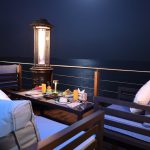When you walk into a Michelin-starred restaurant, you are immediately enveloped in an atmosphere that promises an extraordinary dining experience. Attention to detail and quality permeate every aspect of the restaurant, from the exquisite menu to the precise service. But have you ever wondered about the behind-the-scenes operations that facilitate such flawless dining experiences? The heart of any restaurant lies hidden from the diners’ view – the kitchen. The design and layout of the kitchen are critical factors that greatly impact the restaurant’s performance. Let’s delve deeper into what constitutes an optimal kitchen layout in a Michelin-starred restaurant.
The Importance of Designing the Right Kitchen Layout
Designing a kitchen for a Michelin-starred restaurant is both an art and a science. The layout of the kitchen plays a critical role in facilitating the seamless preparation and delivery of high quality, delectable food. A poorly-designed kitchen can drastically limit the performance of the chef and their team, impacting the quality of food and ultimately, the overall dining experience. Hence, it is essential to focus on efficiency, safety, and functionality when designing a restaurant kitchen.
In parallel : Which ergonomic bar tools can help reduce bartender fatigue during long shifts?
Space Management: The Key to Efficiency
When designing a restaurant kitchen, space management is paramount. The key is to maximize utility out of every square inch, without overcrowding. The kitchen should be spacious enough to accommodate the culinary team, with ample room for them to move around without bumping into each other. The three most important spaces that need careful planning are the preparation area, cooking area, and dishwashing area.
The preparation area should ideally be located near the storage so that chefs can easily access fresh ingredients as needed. The cooking area should be designed with efficiency in mind, with the range, grill, and ovens arranged in a manner conducive to fast-paced, efficient cooking. The dishwashing area should be separate from the food preparation and cooking areas, to maintain cleanliness and prevent cross-contamination.
Also to see : What are the steps to create a successful farm-to-table concept in your restaurant?
Implementing the Right Utilities and Equipment
In a Michelin-starred restaurant, the quality of the food hinges on the culinary tools and equipment used by the chefs. High-end, commercial-grade appliances are a must. These not only ensure the quality of the food but also save valuable time, enhancing efficiency.
The choice of equipment often depends on the restaurant’s menu. For example, a restaurant that specializes in grilled dishes would require top-notch grills and smokers, while a bakery-oriented eatery would invest heavily in high-quality ovens. The appliances should be strategically placed to streamline the cooking process.
Moreover, storage units are crucial in maintaining the freshness and quality of ingredients. Walk-in refrigerators and freezers should be conveniently located, ensuring easy access, and their temperature settings should be regularly monitored to preserve food quality.
The Crucial Role of Safety and Hygiene
In a kitchen where numerous chefs work together in a fast-paced environment, safety can’t be compromised. The layout should ensure sufficient space between appliances to avoid accidents. Heat-producing equipment should be placed in well-ventilated areas to manage the kitchen temperature. Non-slip flooring, fire extinguishers, and first-aid kits are vital safety measures.
Hygiene is equally important. The Michelin Guide takes cleanliness into account when awarding stars. Therefore, elements like easy-to-clean surfaces, efficient waste disposal systems, and separate handwashing stations contribute to maintaining high hygiene standards.
Creating an Environment that Nurtures Creativity
Last but not least, a Michelin-starred restaurant kitchen should foster creativity. After all, it’s the chef’s innovative culinary creations that earn Michelin stars. The kitchen should be a space where chefs can experiment, innovate, and create culinary masterpieces.
Natural light, comfortable temperatures, and adequate ventilation can positively impact the chefs’ morale and productivity. An open kitchen design, where chefs can see the reaction of diners enjoying their food, can also be a source of motivation.
In conclusion, designing the optimal kitchen layout for a Michelin-starred restaurant involves careful planning and a focus on efficiency, safety, and creativity. Every detail, from space management to safety and hygiene, contributes to the superior quality of food and service that Michelin-starred restaurants are renowned for.
The Role of Technology in a Michelin-Starred Kitchen
Emerging technology plays an indispensable role in the operation of a Michelin-starred kitchen. State-of-the-art kitchen equipment can significantly enhance efficiency, precision, and, ultimately, the quality of the food. Indeed, in the world-renowned French Laundry, a three Michelin starred restaurant, kitchen technologies take centre stage in their quest for culinary perfection.
High-tech appliances such as sous-vide machines, high-speed ovens, and precision scales are integral to the efficient functioning of a Michelin-starred kitchen. Sous-vide machines, for instance, allow chefs to cook food at a precise temperature, ensuring consistent results every time. High-speed ovens can reduce cooking times significantly, enabling the culinary team to serve patrons faster. Precision scales let chefs measure ingredients accurately, essential for replicating complex recipes consistently.
In addition to these tools, Michelin-starred chefs often use digital technology to streamline operations. Kitchen management software helps in tracking inventory, scheduling tasks, and monitoring equipment performance. Some restaurants even use advanced systems that employ artificial intelligence to predict dining trends and plan menus accordingly.
However, it’s crucial to remember that technology should aid and not overshadow the chef’s skills. After all, Michelins stars are awarded for the chef’s ability to create exquisite dishes, not for the kitchen’s tech-savviness.
Conclusion: Achieving Michelin-Worthy Excellence in Kitchen Design
In the end, the optimal layout of a kitchen in a Michelin-starred restaurant is about more than just a well-planned design or state-of-the-art appliances. It is a fine balance between efficiency, safety, creativity, and technological innovation. It’s about creating an environment that enables the culinary team to produce the highest quality of food consistently and efficiently.
The kitchen design should be fluid and adaptable, able to support the evolving needs of the culinary team. For instance, if the restaurant owner decides to introduce new menu items, the kitchen layout should be flexible enough to accommodate the necessary changes. Similarly, if the restaurant earns additional Michelin stars, the kitchen should be capable of handling the increased demand without compromising on quality.
Hence, the perfect Michelin-starred kitchen layout is one that marries functionality with creativity. It should be a space where chefs feel inspired and motivated to create culinary masterpieces, while also ensuring their safety and productivity.
Overall, the design and layout of a Michelin-starred kitchen significantly contribute to the memorable dining experience patrons have come to associate with these top-tier establishments. Therefore, every restaurant aspiring for Michelin stars should invest time and resources in planning the optimal kitchen layout, as it is integral to their pursuit of culinary excellence.






